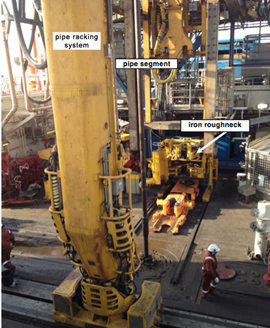

Chikyu 剑指钻位,蓄势待发2012年04月09日
2012年4月3日上午8:00(北京时间7:00),“Chikyu(地球号)”在从清水港启航41个小时后到达了IODP 343航次预定的钻探位置。本航次的全名为“Japan Trench Fast Drilling Project (JFAST)”,即“日本海沟快速钻探计划”,目的是在2011年日本东北“3.11”地震海域7000米海底的板块消减带实施钻探,向海底钻进1000米,钻穿引发3.11地震的断层,在钻孔中安装长期温度和压力观测系统,并对钻取的断裂带样品进行各种岩石物理性质的综合研究,探讨板块消减带地震的发生机理。在此次地震中,该消减带区域发生了前所未有的约50米的滑移,并引发了巨大的海啸,造成了世人关注的人员和财产损失。因此,该计划对于深入理解板块消减带的孕震机理,研究如此巨大滑移量的产生机制具有重要的意义。
担当本航次钻探任务的“Chikyu”是目前世界上最为先进的科学钻探船。船体全长210米,宽38米,高130米(其中钻塔高70米),吃水9.2米,总吨位56752吨,海底最深钻探深度可达7000米,能够钻进前所未能的地幔。船上装备了先进的隔水管钻进系统和动态定位系统,可保证在风速23米每秒,浪高4.5米的情况下,船体相对一个固定位置持续地钻进。同时配备了先进的质量分析与质量控制(QA/QC)取样室、微生物学实验室、X射线CT扫描实验室、地球化学实验室、岩心实验室和古地磁实验室以及数据整合系统—J-CORES,各实验室均拥有各领域最为先进的仪器和设备,可满足船上科学家开展研究工作的基本需求。
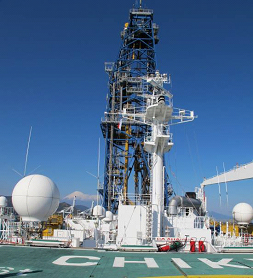
4月1日下午15:00清水港,Chikyu高耸的钻塔与远处的富士山道别。你找到富士山了吗?
该航次的两位首席科学家分别是日本京都大学防灾研究所的Jim Mori教授和美国德克萨斯A&M大学的Frederick M. Chester教授。他们将领导来自10个国家的28名科学家共同完成这项伟大的科学使命。该航次的Science Party有3名中国科学家,分别是来自日本海洋开发研究机构(JAMSTEC)高知岩心研究所(KOCHI)的林为人(Weiren Lin)研究员、加拿大维多利亚大学(University of Victoria)的研究生孙田昊哲(Tianhaozhe Sun)和中国地震局地球物理研究所(Institute of Geophysics, CEA)的副研究员杨涛(Tao Yang)。
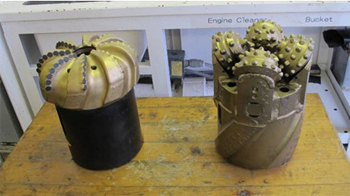
带领我们进入海底世界的“利器”
从一上船,大家就开始为钻探前的各种准备工作忙碌起来,航次Managers为大家介绍船上各种设施,讲解规定,带领大家熟悉船上的各个实验室,认识完成钻探任务的各种装备系统。然而就在大家刚刚进入工作状态的时候,太平洋也为大家的到来“欢呼”起来,自4月3日下午至5日上午,海上台风持续大作,最大风速超过40米每秒,超过13米的巨浪拍打着“Chikyu”,很多人第一次感受到了什么叫“大风大浪”。虽然船上不允许喝酒,大家还是在禁酒三天后集体“醉”了:东倒西歪,不会走直线并且食欲不振。WOW(waiting on weather,噢),这感觉真是not so good。尽管如此,大家仍然克服困难在各自的岗位上兢兢业业地工作,为向7000米海水下的“神秘地带”进军而做最后的准备,这可是世界海洋钻探史上未曾有过的海水深度。对“Chikyu”而言,它是个巨大考验;对船上的科学家而言,是挑战更是机遇。然而,经历过“大风大浪”的人们总是对未来充满信心。
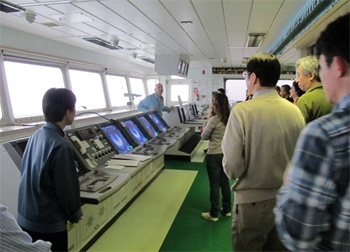
“Chikyu”的“司令部(headquarters)”—Bridge


Chikyu: A Truly Impressive Vessel!2012年04月09日
I had been eagerly awaiting the ship tour since the day we set sail, and once the storm passed, the night crew, which includes yours truly, finally got to go. The Chikyu is by far the largest vessel I have ever been on; she’s approximately 210 meters in length and 130 meters in height (from hull to the top of the drilling derrick). Before I left New Hampshire, I was joking with my friends that my biggest fear about the expedition was that I would get lost in the ship on the first day and not found until we come back into port the end of May.
The first stop on the tour was the pipe assembly area, where we had the opportunity to see how the roughnecks, the crew that works on the drill rig, prepares the drill pipe to make the 8-km journey down into the seafloor. Each pipe segment is 9 meters long. It takes a huge winch to pick up each segment of pipe and get it into place. Once two pipe segments are aligned and ready to be connected, a machine called the iron roughneck comes in a screws the pieces together. It is amazing to watch the whole process. Chikyu has been preparing pipe for a couple days now, and they are still going. That is A LOT of pipe.
In the engine control room we met the chief engineer, who told us about some of Chikyu’s operational capabilities. The Chikyu runs off 8 generator engines, which together are capable of generating enough power to run 3000 average-sized homes! There are also 6 thrusters that allow Chikyu to maintain her position in the water to within a few centimeters! There are also four fresh water generators onboard that produce an amazing 200 tons of fresh water a day. With all these capabilities, Chikyu can travel 9000-km or roughly 100-days without needing to resupply.
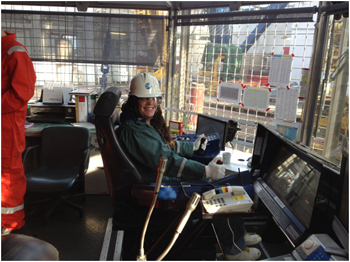
Me sitting in the driller's chair
Chikyu is a truly impressive ship, and I am excited to see the rig floor in action when we start drilling.


Spring storm2012年04月06日
We arrived at the drill site on April 3 and shortly there after were met by a large spring storm (Article on storm). We had 30 m/s and 8-10 m high waves. We started seeing WOW on all of the drilling progress updates. Thought it was an exclamation about how big the storm was, turns out it just means "waiting on weather". Really it wasn't that bad on the ship. Some people got seasick on the 4th, thanks to medication I was not among them but I was a little queasy. We weren't allowed out on deck and the elevators and gym were closed. It was pretty cool view from the port window though. There were a lot of white caps and sometimes I could see the separate crests and troughs of the waves passing by the ship but videos and pictures aren't nearly as impressive as the real thing. The storm ended yesterday and we are progressing towards starting to drill!
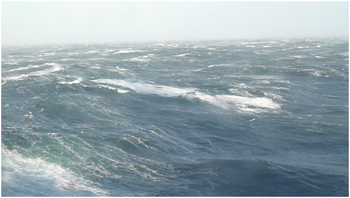
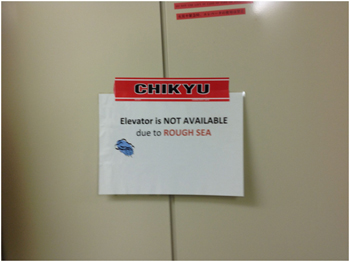


WOW2012年04月05日
Chikyu arrived on the JFAST drill site yesterday and was greeted by typhoon-strength (30m/s) winds whipping up the Pacific into a surging mass of 8-10m high waves. The same storm has shut down airports on the mainland and left many stranded. Tasks scheduled for the drilling preparations have been delayed because the ship is rolling around too much. Fortunately the cruise here from Shimizu went well and we arrived ahead of schedule so the storm has not set things back too badly so far.
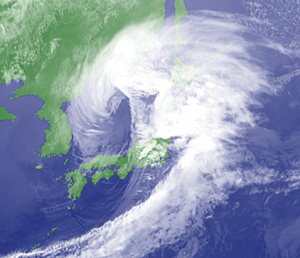
This satellite image shows the extent of the storm we are currently experiencing
(Tuesday, April 3, 2012, Japan Meteorological Agency)
Even though Chikyu is huge, being on board in this weather feels like being in an airplane in severe turbulence. Except the storm has been raging for 24 hours! Walking in straight line is a distant memory and all of the outside deck areas are currently off limits thanks to the wind. The science party has had a tough introduction to the high seas, even the old hands are impressed at the longevity of this storm! Some people seem to have been completely unaffected, but there are definitely some green faces around, mine included.
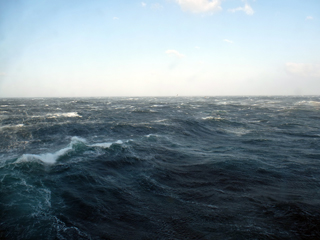
The view from the porthole. 8 ? 10 m waves are crashing constantly against the side of the boat and the swell is causing the boat to roll and rock significantly. Hopefully it will blow over soon!
Despite the conditions, the science party continues to work hard to prepare for the drilling phase of the expedition. We are in an intense planning and training phase, working around the clock. As a group we are finalizing the design of the experiment here, deciding on the optimum layout for the drill holes. Every scientist will have a specific role once the operation is underway. Each person needs to become intimate with the tools they will be using, but it is fantastic how everyone is working together and sharing experience and ideas for improving on established methods, techniques and technologies. As a newcomer to the ocean drilling program, I feel lucky to be able to work and learn from the collection of world experts that make up the science team. The learning curve is steep but it the enthusiasm of the group is amazing, and the sense of working towards a common goal is inspiring.
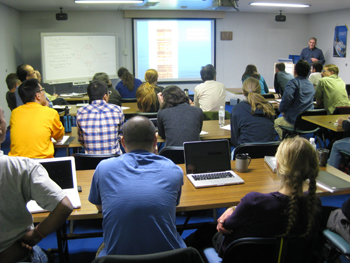
Legendary scientist Casey Moore explains how faults are identified in drill holes from logging data.
The first stages of the drilling operation will be incredibly exciting: an underwater TV will be lowered 7km down to the sea floor to peer around and scope out the site. The engineers will try to find two sites to locate the drill head amongst the rocks. Will there be any friendly crabs to help out? Who knows, but one thing for sure is I can’t wait for the drilling to begin!
For now the plan is to Wait Out the Weather.


What is Namazu?2012年04月04日
According to Japanese mythology Namazu is a giant catfish that lives in the mud beneath the islands of Japan. Namazu is restrained by the god Kashima but when Kashima lets down his guard Namazu moves and the result is an earthquake. On March 11, 2011 during the Tohoku earthquake Namazu moved a lot.
Now one year later IODP expedition 343 - Japan Trench Fast Earthquake Drilling Project (JFAST) has set off to study the Tohoku subduction zone on the deep sea scientific drilling vessel Chikyu. The water depth where we will be drilling is 6910 meters below sea level. Chikyu will drill as much as 1000 meters below the seafloor to reach the fault zone. Drilling has never been done to such depths before. We will measure fault zone physical properties, recover material from the fault zone, and record the temperature anomaly that resulted from frictional slip during the Tohoku Earthquake. From this information we will learn more about the fault zone and why it slipped.
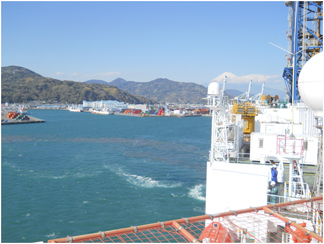
Leaving land behind and heading to the drill site located off the Oshika Peninsula.
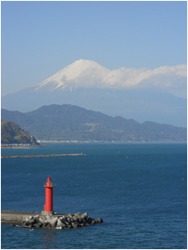
View of Mount Fuji from the heli deck


Arriving at the borehole site2012年04月04日
This morning at 8 am, after 41 hours of transit, we arrived at the location of our first borehole. I was able to track our route with a hand-held GPS from the port at Shimizu to our current location at JFAST 3, located about 250 km east of Sendai. It was nice to be able to watch our progress on the GPS map. We had little way of knowing our position otherwise because we were far from shore and could only see the ocean for miles.
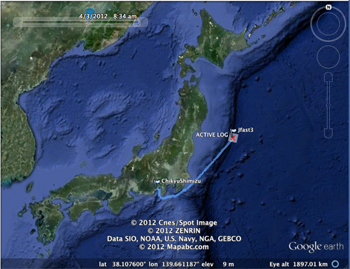
Map of our route from Shimizu to the borehole site.
This is my first time at sea, and I wasn't sure what to expect in terms of sea sickness. For the first day, the motion of the boat was so slight that I had a hard time discerning weather or not it was even real. It's a very odd effect because you have no stationary reference frame inside the boat. It kind of feels like you are in a flight simulator at an amusement park. Your body feels the change in acceleration with every wave, but because everything in the room is moving with you, your mind does not know how to process the motion. It can be very disorienting until you get used to it, and I have stumbled off my feet a couple of times in big waves. It is actually is much easier to handle when you are out on deck or looking out of a window and can see the horizon.
Unfortunately, some bad weather has moved in today and we cannot start operations until the waves calm down. As of this afternoon there were swells of ~5m, and it is likely that they will be up to 10-15m by night. Already the boat is rocking with quite a fervor, and the drilling derrick (tower) is making an eerie, grinding, metallic noise as it compensates for the ship's movement. Luckily, we've had two days to get somewhat acclimatized to the constant motion. In addition, the Chikyu is a very large boat, and is quite stable in comparison to smaller vessels. But I think we will all find out tonight just how good our "sea legs" are.
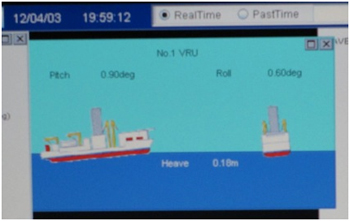
This computer monitors the pitch and roll of the ship.
As we prepare to begin drilling operations, the scientists on board have been taking part in many discussions about the project, how we want to position the boreholes, and what data we can use to definitively locate the fault zone. In addition to scientific discussions, we were able to get a tour of the drilling operations portions of the ship. The engineers, drillers, and mechanics have tough jobs and it is because of their work that we can even hope to be able to examine data from this fault zone. It was great to get to see their work stations and thank them for their efforts.
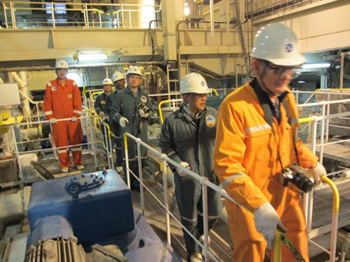
Members of the science party get a tour of the drilling operations.


Anniversary of 1st Deep Ocean Drilling2012年04月02日
Today marked our first full day at sea on this historic ultra-deep ocean drilling and observatory installation expedition. We are all quite excited and prepared to take on the many challenges that will be involved.
Interestingly, today also marked another historic event in the history of scientific ocean drilling and our understanding of the Earth. It was on this day, 51 years ago on April 2nd 1961 that the very first deep ocean drilling expedition collected core samples confirming that the oceanic crust was composed of basalt (a volcanic rock). This was just one of many discoveries at the time that contributed to the development of the theory of plate tectonics.
I was surprised to learn that the shipboard historian on the expedition was none other than the very famous author, John Steinbeck, who later wrote an article about the adventure for LIFE Magazine.
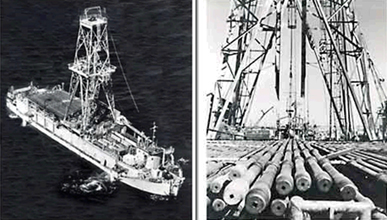
An overhead view of the CUSS 1, the first scientific deep ocean drilling vessel. It was converted from an old Navy barge. While it is small and simple compared to the Chikyu, some the technology developed for it use, including dynamic positioning (using steerable thrusters or propellers to stay in one spot), is still used on the Chikyu today. (US-NSF Photo)
There was even a short documentary made at the time (The First Deep Ocean Drilling Part I, Part II ) about the engineering challenges they faced drilling in water depths of 3500 m that were roughly 30 times deeper than the depths the industry was drilling at the time. They also sought to take core samples that were considerably longer and deeper than commonly collected and to collect subsurface temperature measurements.
The challenges that were overcome with their expedition are in many ways similar to those associated with the JFAST project. We too will be drilling in water depths (7000 m) that are considerably deeper than even deep water commercial drilling. In addition, while two boreholes have previously been drilled at similar water depths, they were only drilled and cored to ~15 m below the seafloor; we plan to go to ~ 1000 m below the seafloor like IODP expeditions in shallower water, collect long sections of core from the fault zone, and also install underground observatories to monitor temperature and pressure.
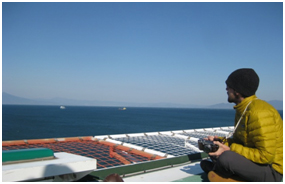
Patrick (perhaps) contemplating the journey ahead
The JFAST project is going to be difficult, but I, for one, am humbled by the achievements and scientific legacy of this first scientific ocean drilling expedition and those that followed. While we too will be using state-of-the-art technology and even some new technology specifically designed for this expedition, in many ways we will be using many of the same techniques that were used and developed by these early ocean drilling scientists and engineers.


清水港を出港して2日経ちました2012年04月02日
清水港を出港して2日経ちました。
今回の航海で、Expedition Project Managerとして乗船している江口です。
私の仕事は簡単に言うと、研究チーム(10カ国から28人乗船中)と、掘削オペレーションチームとの意思疎通をクリアにすること。それに、研究者達の船上、および下船後の研究の手伝いをすること。そして研究者達が幸せな(!)船上生活を送れるようにすることです。
清水でのポートコール中は、これまでの航海ではなかったほどのメディアの人々が取材にいらっしゃり、世の中の人がこの航海に寄せる期待(?)を、ひしひしと感じ、改めて気持ちが引き締まる思いでした。
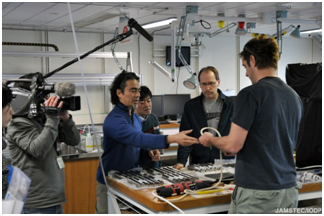
出航前、船上ラボでの取材の様子。今回設置する温度センサーを紹介しました。
右から、わたしと同じくExpedition Project ManagerのSean、首席研究者のFredとJim、そして江口です
この航海はいろんな意味で特殊ですが、中でも我々オペレーション側にとって大変だったのは、なによりも準備期間が短かったということです。(その科学的な理由は首席研究者のレポートに任せるとして)7000mの水深で、その海底下を1000m掘削するという計画を1年足らずで実現に持って行くというのは、並大抵の騒ぎではありませんでした(詳細は省きますが・・・)
昨日出港した時に、富士山が目の前にそびえていました。その富士山を見ていて気がついたのが、私たちは、なんと、この富士山の二倍の高さの距離までパイプを降ろして掘削するのだ!という事です。
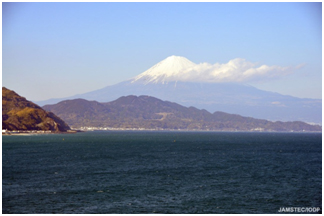
この富士山の二倍の高さの距離まで掘削するのだ!
現在、「ちきゅう」は目的地に向けて航行中です。乗船研究者達は船の生活に慣れ始めたところです。さて、この先どんな事が待ち構えているのでしょうか?
出来るだけ時間を見つけてレポートして行こうと思います!
Stay Tuned!!
Nobu Eguchi


Chikyu sets sail2012年04月01日
Most of the international scientists participating in the JFAST expedition (IODP Expedition 343) arrived in Japan on the 29th of March, 2012, and after a night in Tokyo, made their way on the bullet train to the port of Shimizu the next day. There, we boarded the Chikyu and were introduced to our accommodation, the onboard facilities, and lots of staff of the ship. The facilities are really impressive and I hope to learn a lot about the procedures that are in place to handle and log core, as well as about all the other forms of data that will be recovered (such as geophysical logs). IODP has been doing this sort of work for a long time, and I think there are a lot of good lessons I can learn that I can apply in the next phase of drilling for the Alpine Fault ? Deep Fault Drilling Project (DFDP) in New Zealand.
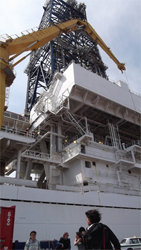
Scientists are dwarfed by the Chikyu’s drill derrick as they arrive and start to board.
In front is Francesca Remitti, from Italy.
The Chikyu stayed in port the next day, allowing some of us to explore the local area, and obtain last minute provisions for the next 54 days at sea. I managed to go for a last run on land this morning, through quaint Japanese streets and orange groves. I discovered a Buddist Zen Temple (Seikenji Temple) dating from 679AD, just up the hill that we went back to visit later. Something I was impressed by is that the locals sell the produce from their back gardens via ‘honesty box’ stalls outside their houses ? this is something we do in my home town in New Zealand as well!
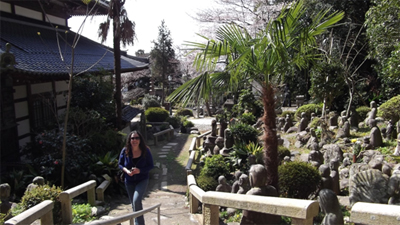
Monica Wolfson (USA) explores the grounds of Seikenji Temple, Shimizu.
Now, its just after 3pm on the 1st of April and the Chikyu has finally set sail. Everyone went out on deck to watch as we pulled away from the port in breezy but sunny conditions. Mt. Fuji was spectacularly visible on the skyline to the north as we sailed away. We’re presently steaming our way out through the harbour mouth and will then start to sail northeast towards the proposed drilling sites. The boat is beginning to sway gently so maybe we’ll all find out how we get on with motion sickness now. We start our shifts tonight, and I am scheduled to work midnight to midday, so I will soon be headed off to bed for a few hours of sleep.
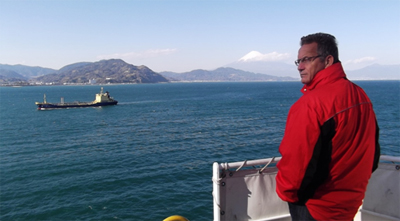
Jan Behrmann (Germany) looks pensively landward
as we steam out of port in the shadow of Mt. Fuji.














